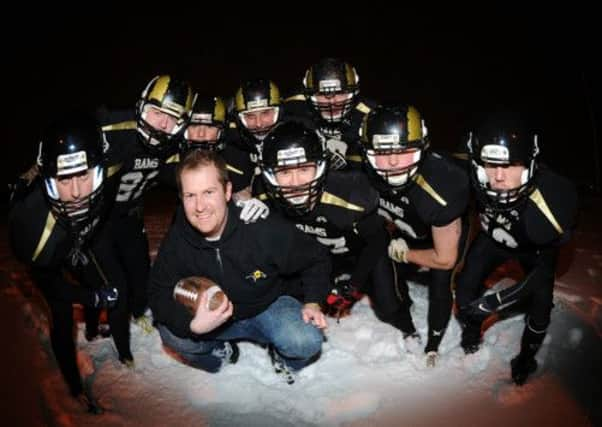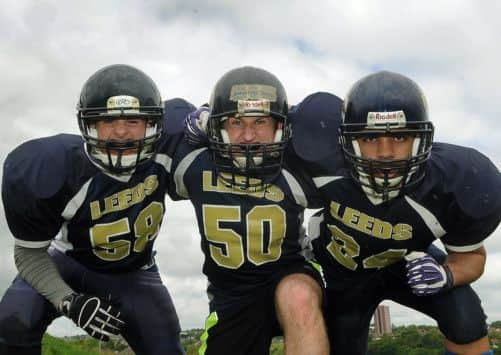Rugby heartland takes a bigger slice of a sport that’s as American as apple pie


JUST why would a new generation of rugby-loving Yorkshiremen turn their attention to any other game, even if that game were a close cousin?
After all, for decades American football, which started growing in popularity in Britain 20 to 30 years ago, could never gain a strong foothold anywhere beyond the south and midlands precisely because union and league continued to dominate northern England.
Advertisement
Hide AdAdvertisement
Hide AdAsk anyone involved in promoting this foreign import, however, and they’ll tell you that rugby fans are gradually starting to see American football as an attractive relation to rugby. The two pursuits share many characteristics in terms of their physical nature, emphasis on teamwork and the sheer grit required.


But what really swings it for converts are the subtle but crucial differences.
“The best way I can describe it is that rugby is a contact sport, while American Football is a collision sport,” says Adam Lilley, manager of the Yorkshire Rams American Football Club.
“Part of the attraction of the game is the big explosive hits. With rugby you tackle someone to get the ball, with American football you tackle to simply stop them.
Advertisement
Hide AdAdvertisement
Hide Ad“It’s far more fast-paced as well, which is largely down to the stop-start nature of the game. There’s the noise too – all the clashing of plastic and metal with each tackle. It’s not just the person with the ball that gets tackled either, everyone is battling against each other on the pitch.
“It really is about bracing yourself mentally and physically for, basically, putting your body on the line.”
All of which sounds even more visceral than rugby, but doesn’t that make it about total brute force and physical domination?
“No, there is a lot more thought process to it than that,” says Lilley “I’m not saying there isn’t a lot of strategising involved in rugby, because I come from a rugby background myself and I know there is, but I’d say there is more in American Football.
Advertisement
Hide AdAdvertisement
Hide Ad“If you want to get the ball as far up the pitch as possible you have to think about clearing a path for someone, or targeting certain players to stop them getting the ball. It requires a lot of planning and quick-thinking.”
There are now between 15 and 20 teams playing across Yorkshire and Humberside, many of which are divided up into youth teams (aged 14 to 17) junior teams (aged 16 to 19) and adult teams (aged 18 and over.)
Most of them are actually based in local universities – Bradford, Sheffield, Huddersfield, Leeds, and York – and it’s telling that most of these entered their respective league over the past ten years. Just a few, like the Hull Sharks, Sheffield Sabres and Leeds Celtics, date back to the late 1980s. The Yorkshire Rams, based in south Leeds, last year celebrated their 25th anniversary and are about to add a youth team to their existing adult team.
And this reflects the rollercoaster fortunes of American Football on this side of the Atlantic.
Advertisement
Hide AdAdvertisement
Hide AdDuring its early years, Channel 4 started screening NFL games and a chunk of the 1980s generation were hooked as a result of consistent exposure to a sport which they’d only previously seen in movies or read about in books.
“I think some of the attraction was also the unique American nature of it,” admits Lilley. “Some of the people who got involved just lapped the whole US thing up.”
But during the 1990s coverage of these matches all but disappeared, with only a relatively small section of the UK population able to access the required cable and satellite TV channels.
But with the turn of the Millennium and the dominance of Sky TV, ESPN (now the main broadcaster of NFL games) was brought back to the masses, delivering a second wave of popularity for the sport.
Advertisement
Hide AdAdvertisement
Hide AdThe British American Football Association (BAFA) is now made up of 51 teams from the far south into Scotland, with training academies and dedicated pitches dotted around Britain too.
In 2007 a spin-off organisation was set up, the British Universities American Football Association (BUAFA) which is made up of over 70 centres of higher education. including Oxford, Cambridge, London and Edinburgh. In fact, there’s barely a major university in the country which doesn’t boast an American football team.
Outside of institutions of higher education, progress is slower but steady.
The two London teams dominate nationally, but in Yorkshire the Doncaster Mustangs and Sheffield Predators rule the roost.
Advertisement
Hide AdAdvertisement
Hide AdAside from the Yorkshire Rams, there are other major players in the region, including the Calderdale Knights and even the Menwith Hill Mustangs, a team made up of players from Menwith Hill Elementary/High School at RAF Menwith Hill in North Yorkshire.
One of the newest additions is the Leeds Bobcats, based at Farnley Sports and Social Club. They were set up just four years ago, but already they have nurtured the best junior side outside of London.
The Bobcats – who are now officially an academy with a dedicated American football pitch – have also produced a string of top local American footballers who’ve gone onto bigger things. Among them Axel Brown who, in a case of coals from Newcastle, was so impressive he was spotted by scouts and is now living the stateside dream playing American football for Colorado State University.
Bobcats head coach Paul Goodward pinpointed the appeal for the young people coming forward.
Advertisement
Hide AdAdvertisement
Hide Ad“There is something for everyone in American football, lots of different positions requiring different skills,” he says.
“We have people come to us who often don’t feel they fit in with other sports. For example, they may be too slow for rugby and too big for football. There’s also a greater sense of teamwork rather than relying on a single star player or individual, and that’s very attractive if you are a team player.”
He also believes the benefits of integrating this US sport with UK culture go beyond the obvious health and camaraderie benefits.
“In the states American football is much more closely linked to education,” says Goodward. “Out there if you play the game at college you have to do well in your studies too. You might be the best player in the world but if you don’t get the grades you need in your academic work they won’t let you onto the pitch. Which I think is very important and perhaps we ought to take a leaf out the American’s book in this respect.
Advertisement
Hide AdAdvertisement
Hide Ad“I think part of the problem with football and rugby is that it is sometimes seen by young people as an alternative to studying rather than an incentive to study more. So there’s this perception that you can just forget schoolwork and go off and be a rugby or a football star. But what do they have to fall back on then? American football doesn’t really work like that.
“With American football you can’t just be fast or big or aggressive, you really have to be smart as well. And, in a way, the structure of the game teaches you a lot of life skills about thinking and working together. And we have every kind of colour, creed and background coming together to play as well. These are all things which you don’t always get so much with other sports.”
To find out more about the Yorkshire Rams visit www.yorkshire-rams.co.uk or to find out more about Leeds Bobcats visit: www.leedsbobcats.co.uk
The rise and rise of American football
November 1869: The first football game was played between teams at Rutgers and Princeton universities.
Advertisement
Hide AdAdvertisement
Hide AdNovember 1892: The first instance of professional play when William “Pudge” Heffelfinger was paid $500 to play for the Allegheny Athletic Association in a match against the Pittsburgh Athletic Club.
November 1920: A group of professional teams established the American Professional Football Association which went on to become the NFL, the National Football League, the sport’s governing body.
January 2012: A record-breaking US audience of more than 111 million and an estimated global audience of nearly 167 million watch the NFL Super Bowl final.